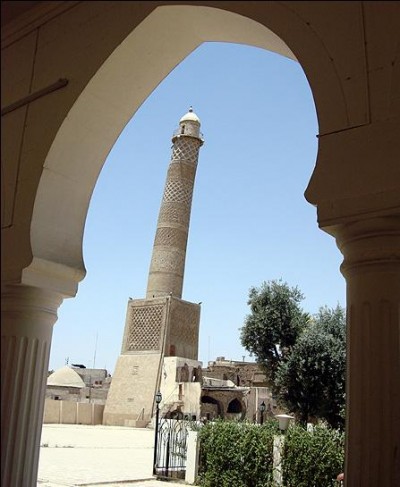FACTBOX – Mosul’s leaning minaret at risk as battle rages

Al-Hadbaa (leaning) minaret in the Grand Nuri al-Kabir mosque in western Mosul.

Baghdad (Reuters) Islamic State’s leader Abu Bakr al-Baghdadi stood up in Mosul’s Grand al-Nuri Mosque on July 4 2014, revealing himself to the world for the first time, declaring holy war and announcing the formation of his caliphate.
Ever since, the militants’ black flag has flown over the medieval brick walls, placing the mosque’s famous leaning minaret at the heart of military and spiritual force that has taken its fight onto the streets of Europe.
Now that U.S.-backed forces are closing in and the shells are falling nearer and nearer in the northern Iraqi city, experts say they fear for the fragile structure, perched on unstable foundations alongside the Tigris river.
Following are some facts about the mosque:
FOUNDATION
The mosque is named after Nuruddin al-Zanki, a noble who fought the early crusades from a fiefdom that covered territory in modern-day Turkey, Syria and Iraq. The mosque was built in 1172-73, shortly before his death, and housed an Islamic school.
MINARET
By the time traveler Ibn Battuta visited two centuries later, the mosque’s 150-foot (45-metre) minaret was already leaning.
Its tilt gave the landmark its popular name – al-Hadba, or the hunchback.
“It is several feet out of the perpendicular,” 19th-century traveler Grattan Geary wrote, “though it starts fair from the ground, and at the top, before putting on its gallery and dome, it regains an erect posture. Its attitude is that of a man bowing.”
It was built with seven bands of decorative brickwork in complex geometric patterns ascending in levels towards the top in designs also found in Persia and Central Asia.
MODERN HISTORY
Both the mosque and its school were dismantled and reassembled in 1942 in a restoration programme by the Iraqi government.
Nabeel Nouriddin, a historian and archaeologist specialising in Mosul and its Nineveh region, said the minaret has not been renovated since 1970, making it particularly vulnerable.
“The Nuri Mosque and al-Hadba minaret are located in the Old City of Mosul where groundwater is a prevailing characteristic,” he said.
“The lack of renovation operations and groundwater combined to weaken the foundations of the minaret over the past four decades. If powerful blasts happen nearby, the risk it could collapse would be more than 90 percent.”
